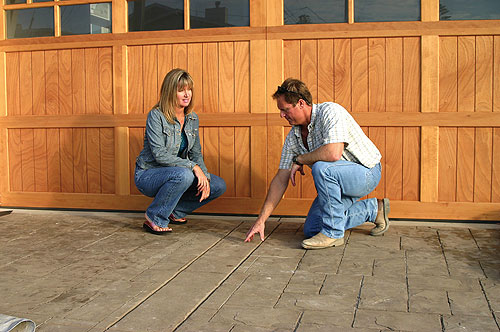 Why Is It So Expensive?
Why Is It So Expensive?
I wish I had 10 cents a square foot for every time I’ve been asked this question. And other questions such as: How much more does stamping cost compared to regular concrete? Are stained floors more than tile? I’ve realized over the years that all the above questions are legitimate and deserve an honest answer. Sometimes as decorative contractors we are quick to defend our prices, but short on justification. Well, hang on, because we are going to answer all of the above and more.
You and I both know decorative concrete is expensive because it’s worth it. Or, is it so expensive? Up until this point the market has perceived concrete as a functional necessity. Driveways existed simply to get from the street to the garage. Concrete slabs were nothing more than durable surfaces to facilitate floor coverings. Concrete created strong foundations, made long-lasting walkways, and helped mom keep the house clean. This durable product makes the perfect canvas for decorative concrete. It just makes sense. Answering why it’s so expensive is easiest by looking at why it’s so popular.
Exterior decorative work such as driveways and walkways is almost a necessity in upper-end landscape projects. Whereas a traditional concrete walk or drive breaks up the flow of landscape, a natural-looking path or drive allows the landscape to blend from left to right. A natural-looking stamped hardscape costs more because it delivers more. The cost isn’t justified by the stamping, but by the complete landscape presentation. The same look can be achieved by using real stone or brick, but at what cost?
What you are offering is a product for a third of the price of real stone with the same effect. Please notice I said effect. Nothing looks more natural than real stone. But remember, the hardscape has several functions. It has to be durable yet natural-looking, as well as affordable. Decorative concrete is the only product that achieves this time and time again.
The same applies to the interior work. A stained floor with decorative saw cuts or stencil is unique and your pricing should be justified by this individuality. A custom concrete countertop should cost $80 to $100 per square foot. Architectural artwork has value. Charge accordingly. Justify your pricing not by comparing to regular concrete or carpet, but by the AFFORDABILITY compared to real stone.
I had a prospective client ask me how much a yard of concrete was going for these days. I must have really floored him with his stamped concrete bid. I apologized for a poor presentation. For him to ask this meant I must not have justified my cost. I felt the best answer to his question was one of my own. I commented on the beautiful paintings he and his wife had collected over the years that they proudly hung on their wall. I asked what he thought the cost of a piece of canvas and few ounces of paint were going for. I didn’t get the job, but my point was made. Our clients aren’t simply buying a gallon of stain or a pail of overlay. They are paying for our skill combined with these ingredients to create a personalized work of art.
Where is your market?
Do you know the difference between a cost-driven and a value-driven client? A cost-driven person only looks at the price you are charging and pays little or no consideration to quality or uniqueness. This is not your market.
A value-driven client weighs skill, quality, and service into their decision to purchase. This is your market. They will pay your cost if you can justify the value. When is the last time you saw Saks Fifth Avenue rolling back prices? Think about it.
There is little doubt the best clients for high-end decorative projects are business owners and the self-employed. These people are used to making decisions, realistic about unforeseen circumstances, and don’t mind spending for things that have value. Put your advertising money in this market.
Is your pricing too cheap?
If you’re not hearing that your company is expensive than you need to raise your prices. Let me explain this. We all agree it costs a lot to do decorative concrete right. If your business is using the best products and providing the best service then why not charge the most money? Your market is used to paying for quality. You are not the exception. Justify your pricing by showing ways your company goes above and beyond the industry standard.
A volume market?
Decorative concrete is not a volume market. There are way too many variables. I know there are a few exceptions to this rule across the country but it is not the norm. Do fewer jobs for more money. The benefit to you is more money trickles to the bottom line with fewer headaches. Every time I make a run at increasing volume, I lessen quality. Without high quality, I’m just another company doing decorative work. I have had success becoming more efficient, which has led to an increase in volume. Another benefit to staying lean on volume is it allows your business to change with the market. Believe me in saying this, this decorative market has just started and it is constantly evolving. I’m not a big fan on jumping into every new craze entering the market. Listen to what your clients are asking for. This is always the best market indicator.
Your best tools?
Your best tools are not in the toolbox. You want to know where they are? They are at the World of Concrete, in Concrete Decor magazine, at decorative seminars, etc. I truly believe I could teach a crew to stain or stamp in a couple of weeks. A true understanding of your market and justifying cost will take time and continued education. Attend and read everything decorative available and implement these tools into your business.
Good luck, and please feel free to e-mail me with questions or comments.
















